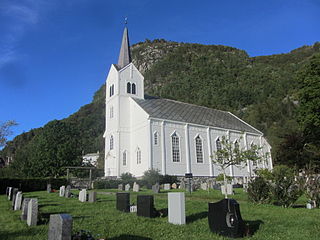
Selje Church is a parish church of the Church of Norway in Stad Municipality in Vestland county, Norway. It is located in the village of Selje. It is the church for the Selje parish which is part of the Nordfjord prosti (deanery) in the Diocese of Bjørgvin. The white, wooden church was built in a long church design in 1866 using plans drawn up by the architect Frederik Hannibal Stockfleth. The church seats about 420 people.

Vereide Church is a medieval parish church of the Church of Norway in Gloppen Municipality in Vestland county, Norway. It is the only stone church in the Nordfjord region. It is located in the village of Vereide, along the eastern coast of the Gloppefjorden. It is one of the four churches for the Gloppen parish which is part of the Nordfjord prosti (deanery) in the Diocese of Bjørgvin. The white, stone church was built in a long church style in the 12th century by an unknown architect. The church seats about 460 people.

Ålhus Church is a parish church of the Church of Norway in Sunnfjord Municipality in Vestland county, Norway. It is located in the village of Ålhus on the northern shore of the lake Jølstravatnet. It is one of two churches for the Ålhus parish which is part of the Sunnfjord prosti (deanery) in the Diocese of Bjørgvin. The white, wooden church was built in a long church style in 1795 by the architect Gunder Gregoriussen Støfringshaug. The church seats about 168 people.

Sande Church is a parish church of the Church of Norway in Sunnfjord Municipality in Vestland county, Norway. It is located in the village of Sande. It is one of the four churches for the Gaular parish which is part of the Sunnfjord prosti (deanery) in the Diocese of Bjørgvin. The white, wooden church was built in a long church style in 1864 using plans by the architect Hans Linstow. The church seats about 300 people.
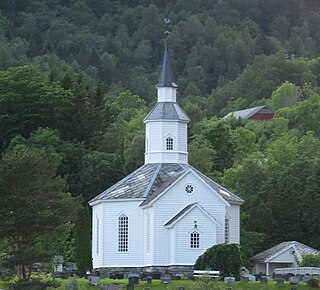
Lavik Church is a parish church of the Church of Norway in Høyanger Municipality in Vestland county, Norway. It is located in the village of Lavik on the northern shore of the Sognefjorden. It is the church for the Lavik parish which is part of the Sunnfjord prosti (deanery) in the Diocese of Bjørgvin. The white, wooden church was built in an octagonal design in 1865 using plans drawn up by the architect Christian Heinrich Grosch. The church seats about 380 people.

Dale Church is a parish church of the Church of Norway in Luster Municipality in Vestland county, Norway. It is located in the village of Luster on the western shore of the Lustrafjorden. It is the church for the Dale parish which is part of the Sogn prosti (deanery) in the Diocese of Bjørgvin. The red and white, stone church was built in a long church design around the year 1240 using designs by an unknown architect. The church seats about 200 people.

Hafslo Church is a parish church of the Church of Norway in Luster Municipality in Vestland county, Norway. It is located in the village of Hafslo. It is the church for the Hafslo parish which is part of the Sogn prosti (deanery) in the Diocese of Bjørgvin. The white, wooden church was built in a long church design in 1878 using plans drawn up by the architect Johan D. Faye. The church seats about 300 people.

Jostedal Church is a parish church of the Church of Norway in Luster Municipality in Vestland county, Norway. It is located in the village of Jostedal. It is the church for the Jostedal parish which is part of the Sogn prosti (deanery) in the Diocese of Bjørgvin. The white, wooden church was built in a long church design around 1660 by builder Hans Ottesen Ravn using plans drawn up by an unknown architect. The church seats about 120 people.
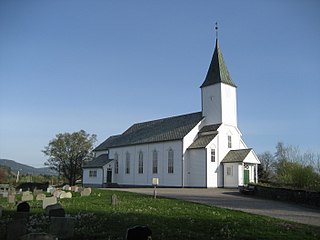
Lindås Church is a parish church of the Church of Norway in Alver Municipality in Vestland county, Norway. It is located in the village of Lindås. It is one of the three churches for the Lindås parish which is part of the Nordhordland prosti (deanery) in the Diocese of Bjørgvin. The white, wooden, neo-Gothic church was built in a long church design in 1865 using plans drawn up by the architect Ole Syslak. The church seats about 370 people.

Manger Church is a parish church of the Church of Norway in Alver Municipality in Vestland county, Norway. It is located in the village of Manger on the island of Radøy. It is one of the four churches in the Radøy parish which is part of the Nordhordland prosti (deanery) in the Diocese of Bjørgvin. The white, wooden church was built in a long church style in 1891 using designs by the architect Hans Heinrich Jess who was from Bergen. The church seats about 440 people.
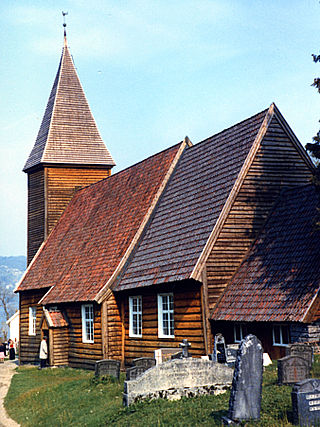
Hamre Church is a parish church of the Church of Norway in Osterøy Municipality in Vestland county, Norway. It is located in the village of Hamre. It is the church for the Hamre parish which is part of the Åsane prosti (deanery) in the Diocese of Bjørgvin. The wooden church was built in a long church design in the late 1500s using plans drawn up by an unknown architect. The church seats about 350 people.

Hosanger Church is a parish church of the Church of Norway in Osterøy Municipality in Vestland county, Norway. It is located in the village of Hosanger on the northern shore of the island of Osterøy. It is the church for the Hosanger parish which is part of the Åsane prosti (deanery) in the Diocese of Bjørgvin. The white, stone church was built in a rectangular design in 1796 by the "leading men" of the parish. The church seats about 275 people.
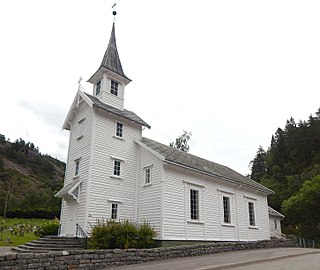
Stamnes Church is a parish church of the Church of Norway in Vaksdal Municipality in Vestland county, Norway. It is located in the village of Stamneshella. It is the church for the Stamnes parish which is part of the Hardanger og Voss prosti (deanery) in the Diocese of Bjørgvin. The white, wooden church was built in a long church design in 1861 using plans drawn up by the architects Peter Høier Holtermann and Jacob Wilhelm Nordan. The church seats about 250 people.

Voss Church is a parish church of the Church of Norway in Voss Municipality in Vestland county, Norway. It is located in the village of Vossevangen. It is the church for the Voss parish which is part of the Hardanger og Voss prosti (deanery) in the Diocese of Bjørgvin. The gray, stone church was built in a long church design in 1277 using plans drawn up by an unknown architect. The church seats about 460 people.

Ullensvang Church is a parish church of the Church of Norway in Ullensvang Municipality in Vestland county, Norway. It is located in the village of Lofthus. It is the church for the Ullensvang parish which is part of the Hardanger og Voss prosti (deanery) in the Diocese of Bjørgvin. The large stone church was built in a long church design around the year 1250 using plans drawn up by an unknown architect. The church seats about 350 people.

Strandvik Church is a parish church of the Church of Norway in Bjørnafjorden Municipality in Vestland county, Norway. It is located in the village of Strandvik. It is one of the churches for the Fusa parish which is part of the Fana prosti (deanery) in the Diocese of Bjørgvin. The white, wooden church was built in a long church design in 1857 using plans drawn up by the architect Frederik Hannibal Stockfleth. The church seats about 450 people.

Tysnes Church is a parish church of the Church of Norway in Tysnes Municipality in Vestland county, Norway. It is located in the village of Våge on the northern shore of the island of Tysnesøya. It is the church for the Tysnes parish which is part of the Sunnhordland prosti (deanery) in the Diocese of Bjørgvin. The white, wooden church was built in a long church design in 1867 using plans drawn up by the architects Georg Andreas Bull and Hartvig Sverdrup Eckhoff. The church seats about 370 people.

Old Moster Church is a parish church of the Church of Norway in Bømlo Municipality in Vestland county, Norway, and it is one of the oldest churches in all of Norway. It is located in the village of Mosterhamn on the island of Moster. It used to be the main church for the Moster parish which is part of the Sunnhordland prosti (deanery) in the Diocese of Bjørgvin. The white stone church was built in a long church design in the 12th century using plans drawn up by an unknown architect. The church seats about 80 people.

Kvinnherad Church is a parish church of the Church of Norway in Kvinnherad Municipality in Vestland county, Norway. It is located in the village of Rosendal. It is the church for the Rosendal parish which is part of the Sunnhordland prosti (deanery) in the Diocese of Bjørgvin. The white, stone church was built in a long church design in the mid-1200s using plans drawn up by an unknown architect. The church seats about 380 people.

Skånevik Church is a parish church of the Church of Norway in Etne Municipality in Vestland county, Norway. It is located in the village of Skånevik. It is one of the churches for the Skånevik parish which is part of the Sunnhordland prosti (deanery) in the Diocese of Bjørgvin. The white, wooden church was built in a long church design in 1900 using plans drawn up by the architect Hartvig Sverdrup Eckhoff. The church seats about 400 people.


























